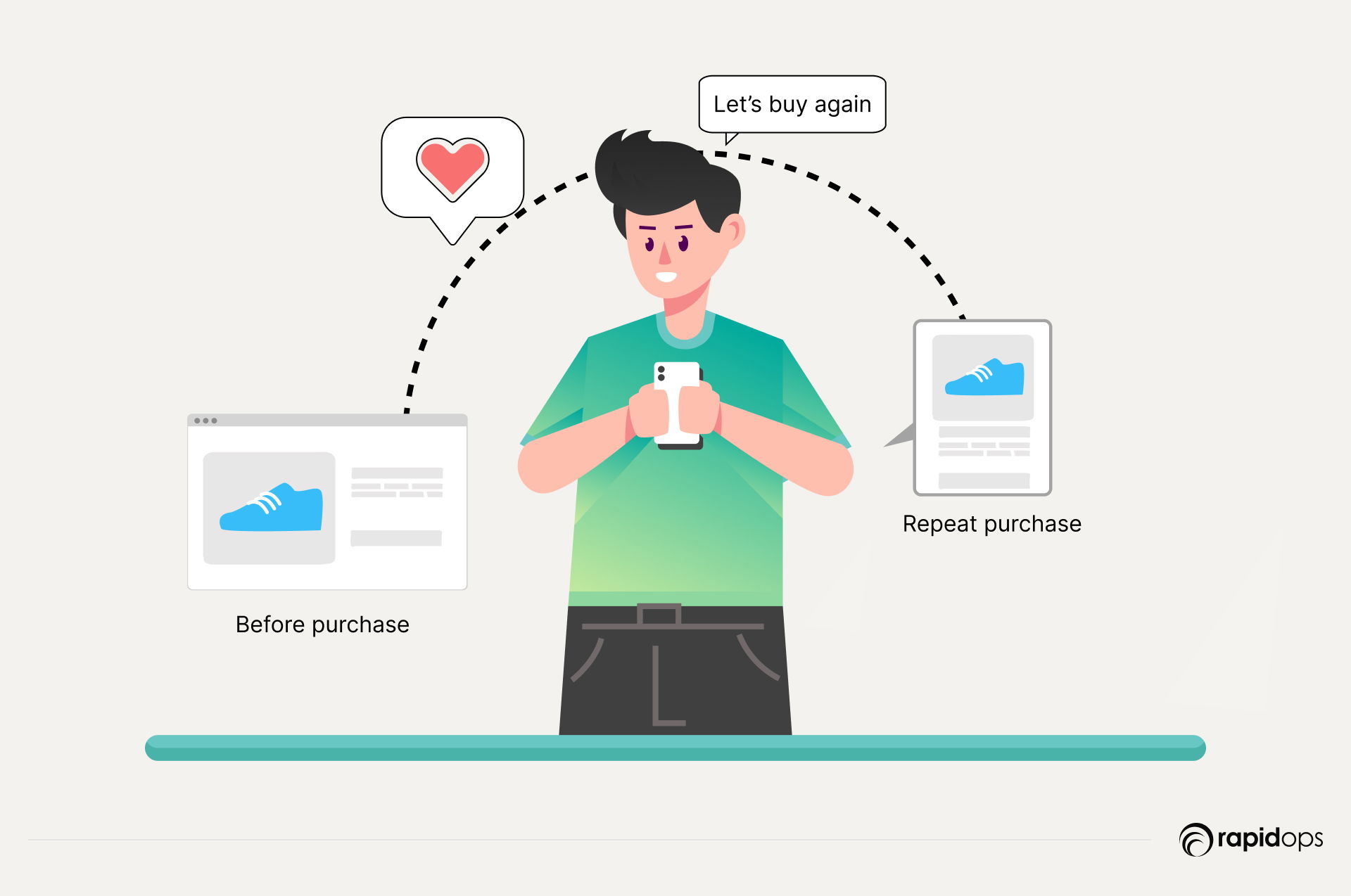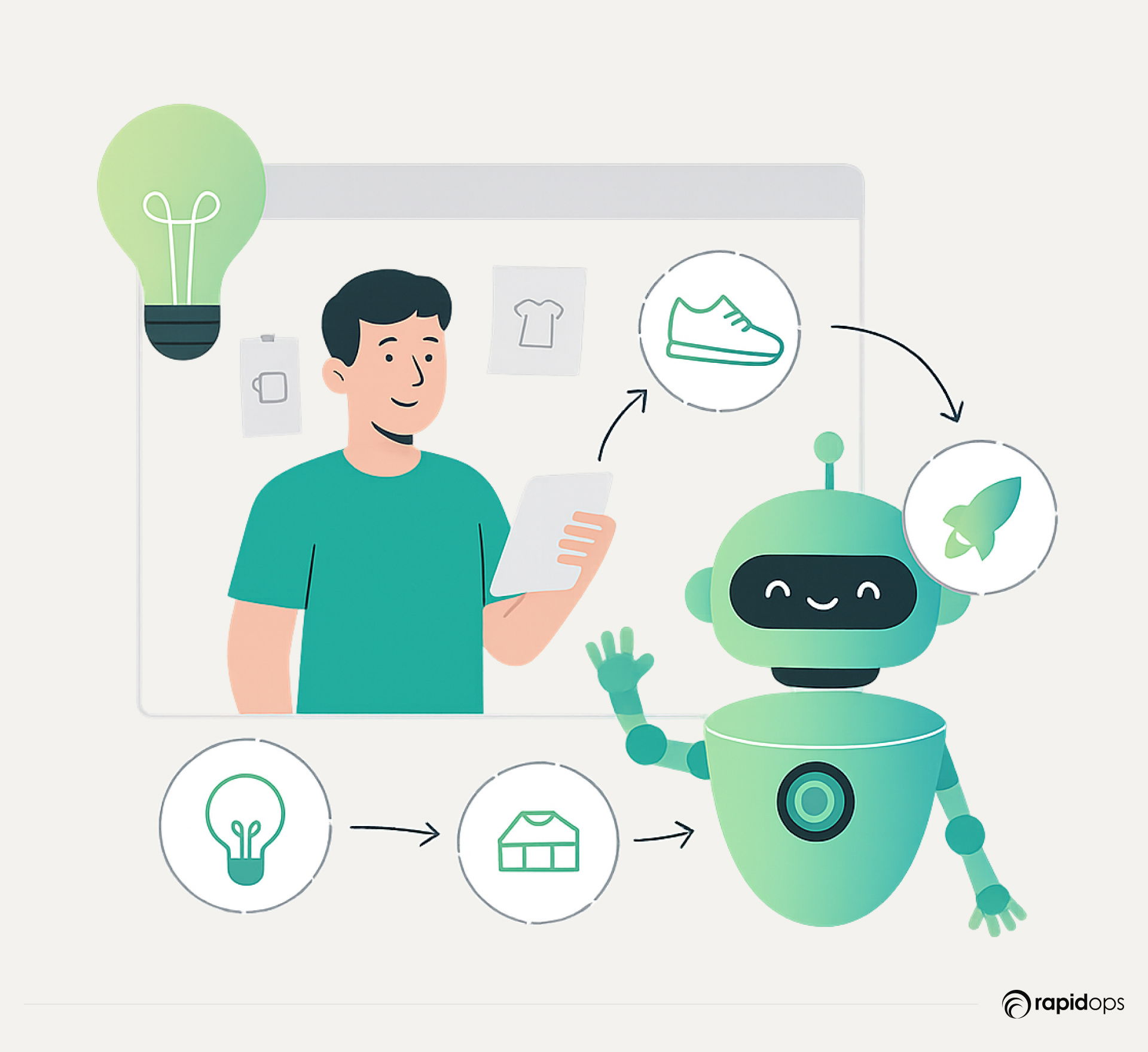Retail has always been a game of margins: anticipating demand, moving inventory at the right time, and creating experiences that keep customers coming back. But today, these fundamentals face pressures unlike anything in the past.
Consumer expectations shift faster than ever; supply chains are more volatile due to global disruptions, and rising operational and input costs are tightening margins in ways retailers haven’t seen before. Incremental improvements are no longer enough to stay competitive.
This is why generative AI for retail has become more than a technology trend; it is a powerful profit engine. Unlike earlier AI systems limited to recommendations or automation, Generative AI now transforms the economics of retail itself: dynamic pricing that protects your margins in real time, AI-driven demand forecasting that reduces stockouts, hyper-personalized campaigns that lift conversions, and AI-generated product content that accelerates speed-to-shelf. And these are just a few of the forces reshaping the retail landscape.
The results are measurable and immediate. Forward-thinking retailers leveraging Generative AI are seeing higher basket sizes, faster inventory turns, reduced operating costs, and stronger profit margins. What was once experimental is now driving retail transformation, operational efficiency, and competitive advantage, giving businesses a clear edge in 2025 and beyond.
In this article, we’ll explore the most impactful generative AI use cases in retail, the KPIs that matter most, and the strategic playbook you can use to turn pilots into enterprise-wide profit growth.
1. Hyper-personalized customer experiences that boost engagement

Retailers have always known that personalization drives loyalty, yet many still rely on broad segmentation and generic campaigns. The challenge is that today’s retail customers compare every interaction not just to competitors, but to the best digital experiences they encounter anywhere.
When offers feel irrelevant or repetitive, shoppers disengage, leading to missed sales, reduced loyalty, and growing customer dissatisfaction. In an increasingly digital marketplace, this gap between consumer expectations and retail execution has become a critical barrier to growth.
How generative AI empowers personalization
Generative AI is enabling retailers to move beyond traditional methods and deliver one-to-one personalization at scale. By integrating vast amounts of customer data purchase history, browsing activity, loyalty interactions, and contextual signals such as time of day, season, or location, AI-driven solutions can generate accurate responses and recommendations in real time. This means a customer browsing online for sneakers isn’t shown a generic promotion, but a curated collection that aligns with their style preferences, past purchases, and even optimal stock levels available in nearby stores. Such hyper-personalized shopping experiences directly enhance customer satisfaction and increase conversion rates.
Personalization across every channel
The retail industry is no longer limited to digital storefronts. Customers expect the same level of personalization whether shopping online, engaging with virtual shopping assistants, or walking into physical stores. Generative AI tools allow retailers to extend personalization into every channel:
- Digital experiences: Tailored promotions, automated content creation, and personalized marketing strategies that adapt to specific customer segments
- In-store interactions: Smart kiosks and AI-powered assistants that recommend products based on customer preferences and past interactions
- Omnichannel consistency: A unified journey that ensures messaging, offers, and recommendations remain relevant across apps, email, social media, and loyalty programs
From reactive to predictive engagement
What sets generative AI capabilities apart is the shift from reactive personalization to predictive engagement. By analyzing historical data and identifying patterns, AI systems can anticipate customer behavior—alerting them when it’s time to replenish frequently purchased products, suggesting complementary items, or delivering loyalty incentives before disengagement occurs. This level of foresight improves operational efficiency, reduces excess inventory, and transforms marketing from a cost center into a driver of measurable business growth.
Strategic impact for retailers
For retail leaders, personalization powered by generative AI is more than a customer experience initiative, it is a lever for competitive edge. By leveraging generative AI solutions, retailers can:
- Align inventory management with actual demand, reducing operational costs and lost sales.
- Enhance customer engagement and improve overall customer satisfaction with timely, relevant interactions.
- Strengthen long-term customer loyalty by consistently meeting consumer expectations.
- Differentiate their retail business in a crowded market by making customer experience a strategic asset
Practical benefits at a glance
- One-to-one tailored offers and experiences
- Predictive engagement that drives repeat purchases
- Streamlined processes linking demand forecasting to inventory optimization
- Cross-channel consistency across online shopping and physical stores
- Automated, scalable marketing content for faster execution
- Direct business growth through higher conversion, retention, and customer loyalty
2. Dynamic price forecasting for maximum revenue impact

Pricing has always been one of the most complex levers in retail. Margins are constantly under pressure from fluctuating demand, rising operational costs, competitor pricing wars, and seasonal volatility. Traditional approaches, whether static price tags or broad periodic adjustments, struggle to keep up with the pace of today’s increasingly digital marketplace, where customer behavior and market trends shift by the hour. The result is lost revenue opportunities, excess inventory, and customer dissatisfaction when pricing feels out of sync with real value.
How generative AI transforms price forecasting
Retailers adopting generative AI solutions are now able to forecast and optimize prices dynamically, turning pricing into a strategic profit driver rather than a manual, reactive task. By analyzing vast amounts of historical data, real-time sales activity, competitor signals, and inventory insights, generative AI technologies enable real-time adjustments that maximize revenue while protecting margins.
For example, during demand surges for seasonal products, AI-powered tools can recommend slight price increases to capture value without harming customer satisfaction. Conversely, when faced with excess inventory or end-of-season stock, AI systems can suggest targeted markdowns and personalized promotions to accelerate turnover while minimizing margin erosion. Beyond immediate adjustments, generative AI capabilities simulate scenarios and predict demand trends, allowing retailers to align pricing strategies with broader business goals.
From reactive pricing to predictive intelligence
The real power lies in shifting from reactive markdowns to predictive engagement. AI-driven solutions can anticipate when demand for a category is about to spike, optimize promotional timing, and personalize offers for specific customer segments. This approach not only improves overall customer satisfaction but also supports effective data management, ensuring operational efficiency and cost efficiency across the retail business.
Why it matters for retailers
Dynamic price forecasting is no longer an experimental tactic; it is a proven way for retailers to stay competitive in fast-moving markets. By leveraging generative AI capabilities, retailers gain the agility to:
- Increase revenue while protecting margins in volatile market conditions
- Reduce inventory risk and lost sales by aligning pricing with real-time demand
- Enhance customer engagement with personalized pricing and promotions
- Strengthen competitive edge through faster, data-driven decision-making
Practical benefits at a glance
- Real-time price optimization aligned with demand, inventory, and competitor actions
- Predictive margin management and demand forecasting for strategic planning
- Personalized promotions tailored to specific customer segments
- Scenario-based testing of pricing strategies to reduce operational risk
- Improved profitability, faster inventory turnover, and stronger positioning in the retail industry
3. Accelerating product content creation at scale

Managing thousands of SKUs across multiple channels has become a major challenge for retailers. Delivering product content that is accurate, engaging, and relevant at the speed demanded by today’s increasingly digital marketplace is critical.
Inconsistent descriptions, slow updates, or generic messaging can reduce discoverability, undermine customer satisfaction, and limit revenue potential. Maintaining operational efficiency while meeting rising consumer expectations has become a strategic imperative for retail businesses.
How generative AI empowers content creation
Generative AI solutions enable retailers to create product descriptions, visuals, marketing copy, and personalized recommendations rapidly and at scale. By analyzing product specifications, images, customer reviews, and market trends, AI-powered tools generate content that resonates with specific customer segments, adapts to emerging trends, and ensures consistency across digital and physical channels.
AI also allows content to evolve dynamically. Descriptions, visuals, and recommendations can be adjusted in real time based on inventory levels, pricing changes, customer engagement signals, or trending products. For example, a product that gains popularity on social media can be highlighted in campaigns and descriptions, while personalized offers tailored to specific customer segments improve engagement and conversion likelihood.
Additionally, generative AI continuously monitors engagement metrics such as click-through rates, conversion rates, and time spent on product pages. Insights from this data guide improvements in copy, visuals, and messaging over time, transforming product content from a routine operational task into a strategic lever for growth.
Why it matters
Leveraging generative AI for product content allows retailers to maintain brand consistency, deliver relevant experiences, and respond in real time to changing market conditions. This strengthens operational efficiency, enhances customer engagement, and provides a competitive edge in the retail industry. By turning content into a measurable driver of growth, retailers can improve discoverability, conversion, and overall customer satisfaction.
Practical benefits
- Rapid creation of product descriptions, marketing copy, and visuals aligned with customer preferences
- Personalized content tailored to specific customer segments and behavior
- Consistent brand messaging across online shopping platforms and physical stores
- Real-time updates reflecting inventory levels, pricing changes, and trending items
- Continuous optimization of content based on engagement metrics (CTR, conversions, time-on-page)
- Enhanced discoverability, engagement, conversion rates, and revenue growth
4. Intelligent marketing automation to drive conversions

Retailers today face mounting pressure to deliver timely, relevant, and personalized marketing across multiple channels. Generic campaigns, manual targeting, and slow adaptation to market trends can lead to disengaged customers, lost opportunities, and suboptimal ROI.
Additionally, managing offers, promotions, and loyalty incentives across numerous touchpoints adds complexity. Meeting rising customer expectations while maintaining operational efficiency and consistent brand messaging has become a strategic imperative for retail businesses.
How generative AI enhances marketing performance
Generative AI solutions enable retailers to transform marketing tasks at scale, beyond traditional campaigns. By analyzing customer behavior, preferences, purchase history, engagement patterns, and market trends, AI can generate content for emails, social media, push notifications, in-app messaging, and other marketing touchpoints. Retailers can deliver hyper-personalized marketing strategies that respond dynamically to real-time signals such as trending products, seasonal demand, or shifts in customer behavior.
AI also optimizes targeting, timing, and channel strategy. For example, a VIP customer may receive a tailored email highlighting exclusive offer, while AI simultaneously adjusts social media messaging for broader segments. Predictive segmentation identifies emerging customer groups, anticipates changes in buying patterns, and adjusts marketing initiatives proactively.
Beyond content and targeting, AI supports promotional strategy and offer management. Discounts, bundles, and loyalty incentives can be personalized and optimized for each customer segment, ensuring maximum engagement, conversion, and revenue. Campaigns and offers can adjust dynamically in real time, aligning promotions with inventory levels, market trends, or individual preferences.
Why it matters
Integrating generative AI into marketing transforms it from a reactive function into a strategic growth driver. Retailers can improve customer engagement, increase conversion rates, strengthen loyalty, and optimize promotional effectiveness by delivering data-driven, personalized experiences across channels. Operational efficiency improves as marketing teams spend less time on repetitive tasks and more on strategy and creative initiatives. This approach provides a measurable competitive advantage, ensuring marketing remains aligned with evolving customer expectations and drives tangible business outcomes.
Practical benefits for retailers
- Generation of emails, social media ads, push notifications, in-app messaging, and promotions at scale
- Real-time adaptation of messaging, visuals, offers, and discounts based on engagement and trends
- Multi-channel orchestration ensuring consistent brand voice and optimized performance
- Predictive segmentation to proactively target high-value and emerging customer groups
- Optimized promotional strategy including discounts, bundles, and loyalty incentives
- Increased engagement, conversion rates, customer loyalty, and ROI from marketing initiatives
- Enhanced operational efficiency, enabling marketing teams to focus on strategic and creative priorities
5. Next-generation product discovery that converts

As retail becomes increasingly digital and connected, product discovery has become a key differentiator for driving revenue, engagement, and customer loyalty. Traditional search results, static recommendations, and generic catalogs often fail to engage shoppers, leading to abandoned carts, lost sales, and missed opportunities for cross-selling or upselling.
Retailers face the challenge of delivering relevant, personalized, and seamless discovery experiences across web, mobile, and physical stores while keeping pace with shifting customer behavior, preferences, and emerging market trends. Successfully addressing this challenge requires solutions that can analyze vast amounts of customer and product data to deliver actionable insights in real time.
How generative AI powers smarter product discovery
Generative AI enables retailers to create highly personalized discovery experiences that adapt to individual shopper behavior, preferences, and contextual needs. By continuously analyzing purchase history, browsing behavior, product interactions, social signals, and market trends, AI delivers contextually relevant product recommendations, dynamically optimized search results, and tailored discovery pathways.
This adaptive approach helps shoppers uncover complementary items and explore products they may not have actively searched for, reducing decision fatigue and accelerating purchase decisions. Real-time integration with inventory levels, trending products, and seasonal demand ensures every suggestion is actionable and timely. Over time, AI continuously learns from interactions, improving recommendation accuracy and engagement, and evolving the discovery experience alongside customer behavior.
By turning product discovery into a smart, data-driven journey, generative AI allows retailers to create experiences that are not only personalized but also aligned with operational efficiency, market trends, and revenue objectives.
Why it matters
Next-generation product discovery powered by generative AI enhances the shopping journey, making it intelligent, intuitive, and highly personalized. Retailers benefit from:
- Higher engagement through relevant, tailored recommendations
- Faster conversions and smoother purchase journeys
- Larger basket sizes via context-aware cross-selling and upselling
- Stronger customer loyalty with consistent omnichannel experiences
By proactively connecting shoppers with the right products at the right time, generative AI maximizes revenue potential, improves overall customer satisfaction, and provides a competitive advantage in a fast-evolving retail landscape.
Practical benefits for retailers
- Anticipates shopper intent for faster, more relevant product discovery
- Enhances search and navigation for smarter, more intuitive experiences
- Boosts basket value through context-aware cross-selling and upselling
- Integrates dynamic trends to highlight high-demand or emerging products
- Continuously learns from interactions to refine recommendations and improve accuracy
- Delivers consistent, personalized discovery across web, mobile, and physical stores
- Surfaces complementary items to increase repeat purchases
- Simplifies product exploration to accelerate decision-making
6. Smart inventory management to reduce costs and stockouts

Inventory management has always been a cornerstone of retail profitability, yet traditional methods often struggle to keep pace with volatile demand, supply chain disruptions, and the complexity of omnichannel operations.
Retailers face the dual challenge of avoiding stockouts that frustrate customers and prevent lost sales, while also minimizing overstock that ties up capital and increases holding costs. In an era of rapidly evolving consumer preferences, seasonal trends, and external market factors, managing inventory efficiently requires intelligent, real-time solutions that align stock levels with both business objectives and customer expectations.
How generative AI optimizes inventory management
Generative AI transforms inventory management into a dynamic, predictive, and proactive function. By continuously analyzing historical sales, customer behavior, market trends, supplier performance, and external factors such as weather, social trends, or local events, AI generates actionable insights for demand forecasting, stock allocation, and replenishment prioritization.
AI acts as an intelligent agent that not only identifies low-stock or overstock situations but also recommends optimal reallocation of inventory across stores, warehouses, and channels. It simulates multiple supply chain scenarios to optimize procurement, distribution, and replenishment strategies, helping retailers minimize costs while maintaining product availability.
Additionally, generative AI enables real-time adjustments in response to sudden demand spikes, seasonal surges, or marketing promotions, ensuring that products are available where and when customers need them. When integrated with pricing, marketing, and product discovery strategies, AI provides a holistic, 360-degree view of retail operations, aligning inventory with both operational efficiency and customer satisfaction.
Why it matters
Smart inventory management powered by generative AI turns a traditionally reactive operational task into a strategic growth lever. Retailers can:
- Minimize stockouts and prevent lost sales
- Reduce overstock and associated holding costs
- Improve working capital efficiency
- Enhance the customer experience with reliable product availability
- Strengthen operational resilience and agility
- Gain a competitive advantage through data-driven inventory decisions
By anticipating demand and aligning stock with real-time customer needs, generative AI ensures that inventory management directly contributes to profitability, efficiency, and overall customer satisfaction.
Practical benefits for retailers
- Predictive demand forecasting for all products, locations, and channels
- Real-time inventory visibility with alerts for replenishment or excess stock
- Dynamic stock allocation across stores, warehouses, and omnichannel channels
- Reduced waste and lower holding costs through optimized inventory planning
- Faster response to market shifts and seasonal demand changes
- Integrated inventory strategy aligned with pricing, promotions, and product discovery
- Improved cash flow by reducing capital tied up in excess inventory
7. Generative AI-powered product innovation

As retail becomes increasingly digital and connected, success hinges on the ability to consistently deliver products that excite customers, meet evolving preferences, and drive growth. Traditional product development methods, often slow, siloed, and reactive, leave retailers struggling to keep pace with shifting market dynamics, emerging trends, and competitive pressures.
The consequence is missed revenue opportunities, delayed product launches, and offerings that may not resonate with target audiences. Retailers face the challenge of creating new products quickly, accurately, and in alignment with customer expectations, while minimizing risk and operational inefficiencies.
How generative AI elevates product innovation
Generative AI transforms product innovation from a linear, reactive process into a strategic, intelligence-driven engine for growth. By ingesting vast and diverse datasets, including customer feedback, historical sales, social media trends, competitive intelligence, and supplier insights, AI generates actionable insights that inform new product concepts, design variations, and market positioning.
Retailers can simulate multiple scenarios virtually, evaluating pricing, features, functionality, and supply chain feasibility before committing resources. This reduces costly trial-and-error cycles, accelerates decision-making, and ensures alignment with both operational realities and customer expectations.
Beyond concept generation, generative AI enables scalable personalization, suggesting product variations such as color, features, packaging, or bundling, tailored to specific customer segments. By integrating these insights with inventory planning, pricing strategy, and marketing initiatives, retailers achieve a 360-degree alignment across operations and customer engagement, ensuring new product launches are timely, relevant, and profitable.
Why it matters
Generative AI elevates product innovation into a strategic growth level. Retailers gain the ability to anticipate trends, respond to emerging customer needs, and differentiate offerings in a crowded marketplace. The benefits are multi-fold:
- Accelerated development cycles reduce time-to-market and enable retailers to capitalize on trends faster
- Data-driven design decisions minimize risk, wasted resources, and misaligned launches
- Scalable personalization ensures offerings resonate with diverse customer segments, enhancing engagement and satisfaction
- Integrated insights across marketing, inventory, and operations create a seamless and coordinated approach to product development
By transforming product innovation from a reactive task into a proactive, insight-driven strategy, retailers not only improve revenue potential but also strengthen brand loyalty and competitive positioning. Generative AI allows teams to focus on creative problem-solving and strategic thinking, rather than being consumed by manual analysis.
Practical benefits for retailers
- Rapid generation of data-driven product concepts tailored to current market trends and customer preferences
- Virtual testing and validation to assess feasibility, pricing, and functionality before production
- Scalable personalization for multiple customer segments without increasing complexity or cost
- Seamless integration with inventory, pricing, and marketing strategies for coordinated execution
- Shortened development cycles, enabling timely response to seasonal demand or emerging trends
- Increased likelihood of product success, stronger engagement, and measurable revenue growth
- Continuous learning from real-time feedback to refine future product innovation strategies
8. Fraud detection & prevention with real-time ai insights

In a landscape where retail operations span digital, mobile, and physical channels, fraud has become a persistent and evolving challenge. Retailers must contend with payment fraud, account takeovers, loyalty program abuse, and return scams—threats that can erode revenue, disrupt operations, and damage customer trust. Traditional rule-based detection struggles to keep pace with these sophisticated tactics, making intelligent, proactive solutions essential for protecting profitability and brand reputation.
How generative AI strengthens fraud detection
Generative AI functions as a dynamic risk analyst, continuously analyzing vast amounts of transaction data, customer behavior, and historical patterns to identify anomalies in real time. By learning from purchase history, login activity, device usage, returns, and engagement signals, AI detects suspicious behavior faster and more accurately than static systems. Retailers can simulate potential fraud scenarios across payments, loyalty programs, and returns processes, proactively closing vulnerabilities before losses occur.
Additionally, AI enables granular risk segmentation, prioritizing high-risk transactions or accounts based on customer behavior, geography, purchase type, and contextual cues. This ensures that resources are focused where they deliver the greatest impact, reducing false positives while maintaining a frictionless shopping experience. By combining predictive modeling with continuous learning, AI adapts to emerging fraud patterns, safeguarding revenue and enhancing operational efficiency.
Why it matters
Fraud directly affects margins, operational effectiveness, and customer loyalty. By leveraging generative AI for real-time insights, retailers can mitigate risks faster, minimize financial losses, and prevent operational disruptions. A proactive AI-driven approach transforms fraud management from a reactive cost center into a strategic capability that protects revenue, secures sensitive customer data, and strengthens brand trust.
Practical benefits for retailers
- Real-time detection of anomalies across transactions, accounts, and devices
- Predictive risk scoring to preempt fraudulent activity and prioritize investigations
- Continuous adaptation to emerging fraud tactics through machine learning
- Simulation of potential fraud scenarios to reinforce preventive measures
- Risk segmentation to allocate security resources efficiently
- Reduced financial losses from payment fraud, returns abuse, and account compromises
- Enhanced customer trust through secure, seamless shopping experiences
Unlock the competitive advantage of generative AI in retail
Retail today is no longer just about products on shelves or online catalogs, it’s about anticipating customer needs, delivering seamless experiences, and staying ahead of rapidly evolving market trends.
Forward-thinking retailers are leveraging generative AI to turn insights into action, creating personalized experiences, smarter operations, and measurable business impact. Those who integrate AI strategically are not only responding to change, they are shaping the future of retail, strengthening competitiveness, and building lasting customer loyalty. Generative AI empowers retailers to optimize pricing, enhance product discovery, accelerate product innovation, and streamline operations, driving revenue, reducing costs, and keeping customers engaged.
With 16 years of hands-on experience in AI and digital transformation, Rapidops partners with leading retailers to implement tailored generative AI solutions that deliver tangible results. Our approach ensures AI becomes a strategic growth lever rather than just a technology experiment.
Elevate your retail operations and customer experiences with generative AI. Schedule a session with one of our AI experts to explore strategies tailored to your business that drive growth, optimize efficiency, and strengthen customer loyalty.
Frequently Asked Questions
Is generative AI only useful for eCommerce?
Generative AI is far more versatile than just powering eCommerce. While it enhances online personalization, product recommendations, and automated content generation, it also drives innovation in physical retail. Applications include intelligent inventory allocation, dynamic in-store pricing, automated product labeling, and AI-guided merchandising. Retailers leveraging AI across channels can harmonize customer experiences, reduce operational inefficiencies, and optimize revenue streams both online and offline.
Can small retailers implement generative AI effectively?
Yes. Small and medium-sized retailers can implement generative AI strategically to achieve high ROI without large-scale IT investments. Cloud-based AI platforms, pre-trained models, and modular AI solutions allow smaller businesses to automate personalized marketing, generate dynamic content, forecast demand, and optimize inventory. By focusing on high-impact, scalable use cases, small retailers can compete with larger enterprises, improve customer engagement, and make data-driven decisions with limited resources.
How does generative AI impact retail profitability?
Generative AI impacts profitability on multiple fronts. It enables dynamic pricing strategies that protect margins, predict demand to reduce stockouts or overstock, and automate personalized marketing campaigns to increase conversions. Additionally, AI streamlines operations by automating content creation, inventory management, and product lifecycle decisions. The result is measurable revenue growth, reduced operational costs, higher customer retention, and stronger profit margins across retail operations.
How does generative AI streamline retail operations?
Generative AI streamlines operations by analyzing large datasets from point-of-sale systems, inventory management, and customer interactions to generate actionable insights. Tasks that were traditionally manual, such as generating product descriptions, forecasting demand, and scheduling inventory replenishment, can now be automated with accuracy. This reduces errors, shortens decision cycles, improves cross-team collaboration, and allows staff to focus on strategic initiatives rather than routine operational work.
How can generative AI accelerate product development?
Generative AI accelerates product development by providing predictive insights on consumer preferences, market trends, and product performance. It can generate design prototypes, recommend feature improvements, and simulate potential market responses before launch. By reducing reliance on trial-and-error processes, AI helps retailers bring products to market faster, align offerings with customer demand, and maximize adoption rates, all while minimizing development costs.
How does AI-powered visual merchandising work for online and physical stores?
AI-powered visual merchandising leverages machine learning to optimize product placement, displays, and digital content presentation. Online, it dynamically adjusts product feeds, banners, and recommendations to each visitor’s preferences. In physical stores, AI analyzes shopper movement, engagement patterns, and sales data to inform layout and promotional strategies. By creating visually appealing, personalized, and strategically positioned displays, retailers increase conversion rates, drive higher basket sizes, and elevate overall customer experience.
How can AI-driven sentiment analysis help retail businesses?
AI-driven sentiment analysis scans customer reviews, social media posts, and survey data to reveal patterns in customer satisfaction, emerging trends, and potential pain points. Retailers can use this intelligence to refine product offerings, adjust marketing campaigns, and proactively address service issues. By understanding customer sentiment in real time, businesses can strengthen brand loyalty, enhance the customer journey, and make informed decisions that directly support revenue growth and retention strategies.

Saptarshi Das
Content Editor
9+ years of expertise in content marketing, SEO, and SERP research. Creates informative, engaging content to achieve marketing goals. Empathetic approach and deep understanding of target audience needs. Expert in SEO optimization for maximum visibility. Your ideal content marketing strategist.
What’s Inside
- 1. Hyper-personalized customer experiences that boost engagement
- 2. Dynamic price forecasting for maximum revenue impact
- 3. Accelerating product content creation at scale
- 4. Intelligent marketing automation to drive conversions
- 5. Next-generation product discovery that converts
- 6. Smart inventory management to reduce costs and stockouts
- 7. Generative AI-powered product innovation
- 8. Fraud detection & prevention with real-time ai insights

Let’s build the next big thing!
Share your ideas and vision with us to explore your digital opportunities
Similar Stories
- AI
- 4 Mins
- September 2022

- AI
- 9 Mins
- January 2023


Receive articles like this in your mailbox
Sign up to get weekly insights & inspiration in your inbox.

